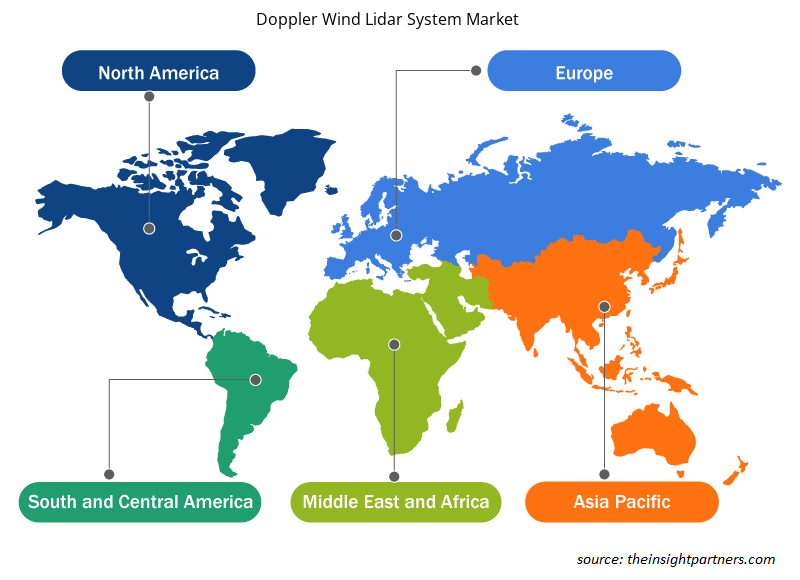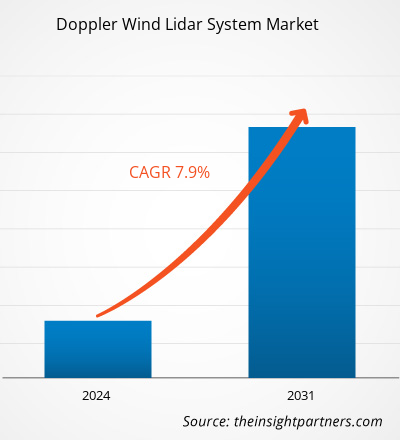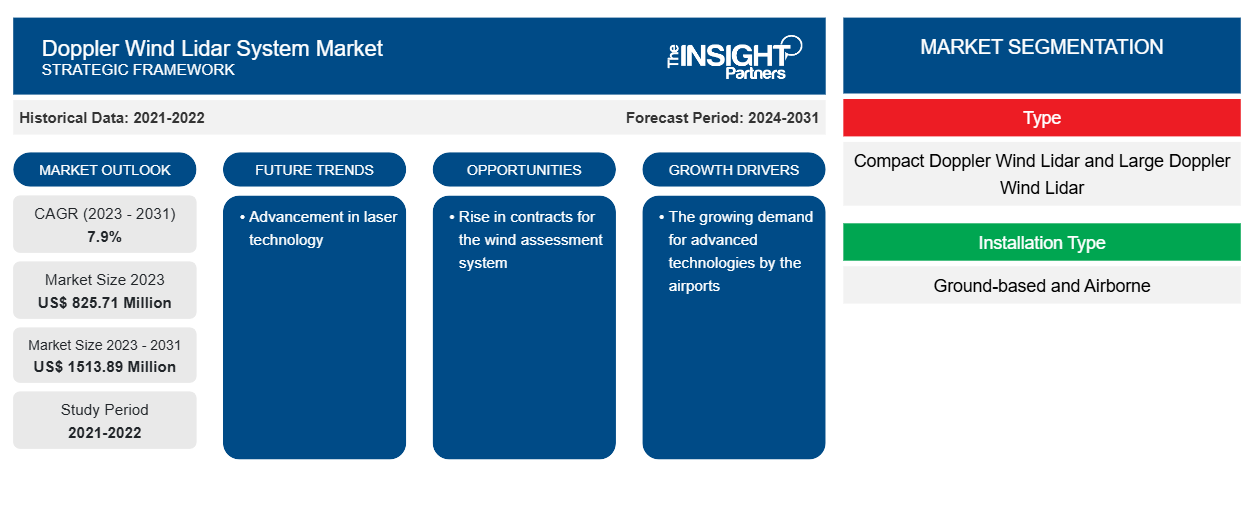Der Markt für Doppler-Windlidar-Systeme soll von 825,71 Millionen US-Dollar im Jahr 2023 auf 1.513,89 Millionen US-Dollar im Jahr 2031 anwachsen. Der Markt wird zwischen 2023 und 2031 voraussichtlich eine durchschnittliche jährliche Wachstumsrate von 7,9 % verzeichnen. Die wachsende Nachfrage der Flughäfen nach fortschrittlichen Technologien und deren Einführung in der Meteorologiebranche dürften weiterhin wichtige Trends auf dem Markt bleiben.
Doppler-Wind-Lidar-System Marktanalyse
Die steigende Nachfrage nach Sensoren und Systemen zur Messung der Richtung und Geschwindigkeit atmosphärischer Winde für Anwendungen wie Flugsicherheitsüberwachung, Windkraftmessung sowie Wetter und Klima treibt das Marktwachstum an. Der wachsende Windenergiesektor ergänzt das Marktwachstum. Die weltweite Nachfrage nach Werkzeugen für effiziente Wettervorhersagen treibt den Markt an.
Marktübersicht für Doppler-Wind-Lidar-Systeme
Doppler-Wind-Lidar-Systeme basieren auf der Theorie des Doppler-Effekts. Dieses System erkennt verschiedene feste und flüssige Partikel, die gleichmäßig in der Atmosphäre verteilt sind, wie Nebel, Dunst, Rauch, Feinstaub und Smog. Es findet Anwendung in Onshore-Windpark-Entwicklungsprojekten, Offshore-Entwicklungsprojekten, der Validierung von Onshore-Leistungskurven und anderen. Zu seinen Funktionen gehören LiDAR, Stromversorgung und Kommunikationssystem.
Passen Sie diesen Bericht Ihren Anforderungen an
Sie erhalten kostenlose Anpassungen an jedem Bericht, einschließlich Teilen dieses Berichts oder einer Analyse auf Länderebene, eines Excel-Datenpakets sowie tolle Angebote und Rabatte für Start-ups und Universitäten.
-
Holen Sie sich die wichtigsten Markttrends aus diesem Bericht.Dieses KOSTENLOSE Beispiel umfasst eine Datenanalyse von Markttrends bis hin zu Schätzungen und Prognosen.
Markttreiber und Chancen für Doppler-Wind-Lidar-Systeme
Der Schwerpunkt liegt auf der Verbesserung der Nutzung von Windsensoren an Flughäfen.
Die Nachfrage nach einem Doppler-Windsensor am Flughafen hilft dabei, den Abstand zwischen Flugzeugen durch Wirbelschleppen zu steuern. Die Steuerung von Wirbelschleppen ist unerlässlich, um potenzielle Gefahren zu vermeiden. Doppler-Lidars sind Sensoren, die Wirbelschleppen messen, um einen sicheren Abstand zwischen an Flughäfen ankommenden Flugzeugen aufrechtzuerhalten. Aus diesem Grund konzentrieren sich die Marktteilnehmer darauf, ihr Produktportfolio zu verbessern und deren sichere Nutzung voranzutreiben. So demonstrierten die SESAR-Partner im Mai 2022 die neue Doppelnutzung von Windsensoren an Flughäfen. Der Test und die Kampagne wurden am Frankfurter Flughafen durchgeführt.
Anstieg der Aufträge für das Windgutachtensystem.
Das Doppler-Wind-Lidar-System liefert ein Echtzeit- und genaues Scherprofil für jede Luftbewegung rund um den Standort. Es ermöglicht dem Bediener, mit einem hohen Maß an Sicherheit zu arbeiten. Solche Bewertungstools sind sehr gefragt. So erhielt EOLOS Floating LiDAR Solutions im März 2024 drei der vier Lose bei der Ausschreibung der niederländischen Regierung für Wind- und Meeresstandortbewertungen in zwei neuen Offshore-Windgebieten. Dies ist der bisher größte Einzelprojektauftrag für EOLOS, so das in Spanien ansässige Unternehmen, das sich kürzlich auch einen Auftrag in Japan gesichert hat. Die niederländische Unternehmensagentur (RVO) hatte EOLOS für schlüsselfertige Wind-, Met-Ocean- und Umweltstandortbewertungen in den Zonen 6 und 7 der Entwicklungs-Roadmap für 2030-2040 ausgewählt. Ein solcher Vertrag für das Windbewertungssystem treibt den Markt für Doppler-Wind-Lidar-Systeme an.
Doppler-Wind-Lidar-System Marktbericht Segmentierungsanalyse
Wichtige Segmente, die zur Ableitung der Marktanalyse für Doppler-Wind-Lidar-Systeme beigetragen haben, sind Typ, Installationsart und Anwendung.
- Basierend auf dem Typ ist der Markt für Doppler-Wind-Lidar-Systeme in kompakte Doppler-Wind-Lidars und große Doppler-Wind-Lidars unterteilt. Das Segment der kompakten Doppler-Wind-Lidars hatte im Jahr 2023 den größten Marktanteil.
- Nach Installationstyp ist der Markt in bodengestützte und luftgestützte Installationen segmentiert. Das luftgestützte Segment wird voraussichtlich mit der höchsten durchschnittlichen jährlichen Wachstumsrate wachsen.
- Nach Anwendung ist der Markt in Flugsicherheitsüberwachung, Windkraftmessung sowie Wetter und Klima segmentiert. Das Segment Windkraftmessung hatte im Jahr 2023 den größten Marktanteil.
Marktanteilsanalyse für Doppler-Wind-Lidar-Systeme nach geografischer Lage
Der geografische Umfang des Marktberichts zum Doppler-Wind-Lidar-System ist hauptsächlich in fünf Regionen unterteilt: Nordamerika, Asien-Pazifik, Europa, Naher Osten und Afrika sowie Süd- und Mittelamerika.
Der asiatisch-pazifische Raum wird voraussichtlich das höchste CAGR-Wachstum aufweisen. Die steigende Nachfrage nach Fernerkundungstechnologien zur Erkennung von Turbulenzen, Gewittern, Flugverkehrskontrolle und anderen Faktoren treibt das Marktwachstum in der Region an. Die Nachfrage nach Wind-Lidar-Systemen für die zukünftigen und bestehenden Flughäfen treibt den asiatisch-pazifischen Markt an.
Regionale Einblicke in den Markt für Doppler-Wind-Lidar-Systeme
Die regionalen Trends und Faktoren, die den Markt für Doppler-Wind-Lidar-Systeme im gesamten Prognosezeitraum beeinflussen, wurden von den Analysten von Insight Partners ausführlich erläutert. In diesem Abschnitt werden auch die Marktsegmente und die Geografie von Doppler-Wind-Lidar-Systemen in Nordamerika, Europa, im asiatisch-pazifischen Raum, im Nahen Osten und Afrika sowie in Süd- und Mittelamerika erörtert.

- Erhalten Sie regionale Daten zum Markt für Doppler-Wind-Lidar-Systeme
Umfang des Marktberichts zum Doppler-Wind-Lidar-System
| Berichtsattribut | Details |
|---|---|
| Marktgröße im Jahr 2023 | 825,71 Millionen US-Dollar |
| Marktgröße bis 2031 | 1513,89 Millionen US-Dollar |
| Globale CAGR (2023 - 2031) | 7,9 % |
| Historische Daten | 2021-2022 |
| Prognosezeitraum | 2024–2031 |
| Abgedeckte Segmente |
Nach Typ
|
| Abgedeckte Regionen und Länder |
Nordamerika
|
| Marktführer und wichtige Unternehmensprofile |
|
Dichte der Marktteilnehmer für Doppler-Wind-Lidar-Systeme: Auswirkungen auf die Geschäftsdynamik verstehen
Der Markt für Doppler-Wind-Lidar-Systeme wächst rasant, angetrieben durch die steigende Nachfrage der Endnutzer aufgrund von Faktoren wie sich entwickelnden Verbraucherpräferenzen, technologischen Fortschritten und einem größeren Bewusstsein für die Vorteile des Produkts. Mit steigender Nachfrage erweitern Unternehmen ihr Angebot, entwickeln Innovationen, um die Bedürfnisse der Verbraucher zu erfüllen, und nutzen neue Trends, was das Marktwachstum weiter ankurbelt.
Die Marktteilnehmerdichte bezieht sich auf die Verteilung der Firmen oder Unternehmen, die in einem bestimmten Markt oder einer bestimmten Branche tätig sind. Sie gibt an, wie viele Wettbewerber (Marktteilnehmer) in einem bestimmten Marktraum im Verhältnis zu seiner Größe oder seinem gesamten Marktwert präsent sind.
Die wichtigsten Unternehmen auf dem Markt für Doppler-Wind-Lidar-Systeme sind:
- Deutsche WindGuard GmbH
- Mitsubishi Electric
- NRG-Systeme
- HALO Photonik
- Vaisala
- ZX Lidars
Haftungsausschluss : Die oben aufgeführten Unternehmen sind nicht in einer bestimmten Reihenfolge aufgeführt.

- Überblick über die wichtigsten Akteure auf dem Markt für Doppler-Wind-Lidar-Systeme
Doppler-Wind-Lidar-System – Marktnachrichten und aktuelle Entwicklungen
Der Markt für Doppler-Wind-Lidar-Systeme wird durch die Erhebung qualitativer und quantitativer Daten nach Primär- und Sekundärforschung bewertet, die wichtige Unternehmensveröffentlichungen, Verbandsdaten und Datenbanken umfasst. Nachfolgend sind einige der Entwicklungen auf dem Markt für Doppler-Wind-Lidar-Systeme aufgeführt:
- Doppler-Lidar-Datenprodukte wurden für 3 ARM-Kampagnen veröffentlicht. Die Benutzereinrichtung Atmospheric Radiation Measurement (ARM) betreibt Doppler-Lidars auf der ganzen Welt, um Messungen der Radialgeschwindigkeit, der gedämpften Aerosolrückstreuung und des Signal-Rausch-Verhältnisses durchzuführen. Die Systeme werden normalerweise mit einem festen Scan-Zeitplan betrieben. Doppler-Lidar-Daten werden verwendet, um Statistiken zu horizontalem Wind und vertikaler Geschwindigkeit abzuleiten. (Quelle: Atmospheric Radiation Measurement (ARM), Pressemitteilung, September 2022)
Marktbericht zum Doppler-Wind-Lidar-System – Abdeckung und Ergebnisse
Der Bericht „Marktgröße und Prognose für Doppler-Wind-Lidar-Systeme (2021–2031)“ bietet eine detaillierte Analyse des Marktes, die die folgenden Bereiche abdeckt:
- Marktgröße und Prognose für Doppler-Wind-Lidar-Systeme auf globaler, regionaler und Länderebene für alle wichtigen Marktsegmente, die im Rahmen des Berichts abgedeckt sind
- Markttrends für Doppler-Wind-Lidar-Systeme sowie Marktdynamiken wie Treiber, Einschränkungen und wichtige Chancen
- Detaillierte PEST/Porters Five Forces- und SWOT-Analyse
- Marktanalyse für Doppler-Wind-Lidar-Systeme mit wichtigen Markttrends, globalen und regionalen Rahmenbedingungen, wichtigen Akteuren, Vorschriften und aktuellen Marktentwicklungen
- Branchenlandschaft und Wettbewerbsanalyse, einschließlich Marktkonzentration, Heatmap-Analyse, prominenten Akteuren und aktuellen Entwicklungen auf dem Markt für Doppler-Wind-Lidar-Systeme
- Detaillierte Firmenprofile
- Historische Analyse (2 Jahre), Basisjahr, Prognose (7 Jahre) mit CAGR
- PEST- und SWOT-Analyse
- Marktgröße Wert/Volumen – Global, Regional, Land
- Branchen- und Wettbewerbslandschaft
- Excel-Datensatz
Aktuelle Berichte
Verwandte Berichte
Erfahrungsberichte
Grund zum Kauf
- Fundierte Entscheidungsfindung
- Marktdynamik verstehen
- Wettbewerbsanalyse
- Kundeneinblicke
- Marktprognosen
- Risikominimierung
- Strategische Planung
- Investitionsbegründung
- Identifizierung neuer Märkte
- Verbesserung von Marketingstrategien
- Steigerung der Betriebseffizienz
- Anpassung an regulatorische Trends























 Kostenlose Probe anfordern für - Markt für Doppler-Wind-Lidar-Systeme
Kostenlose Probe anfordern für - Markt für Doppler-Wind-Lidar-Systeme